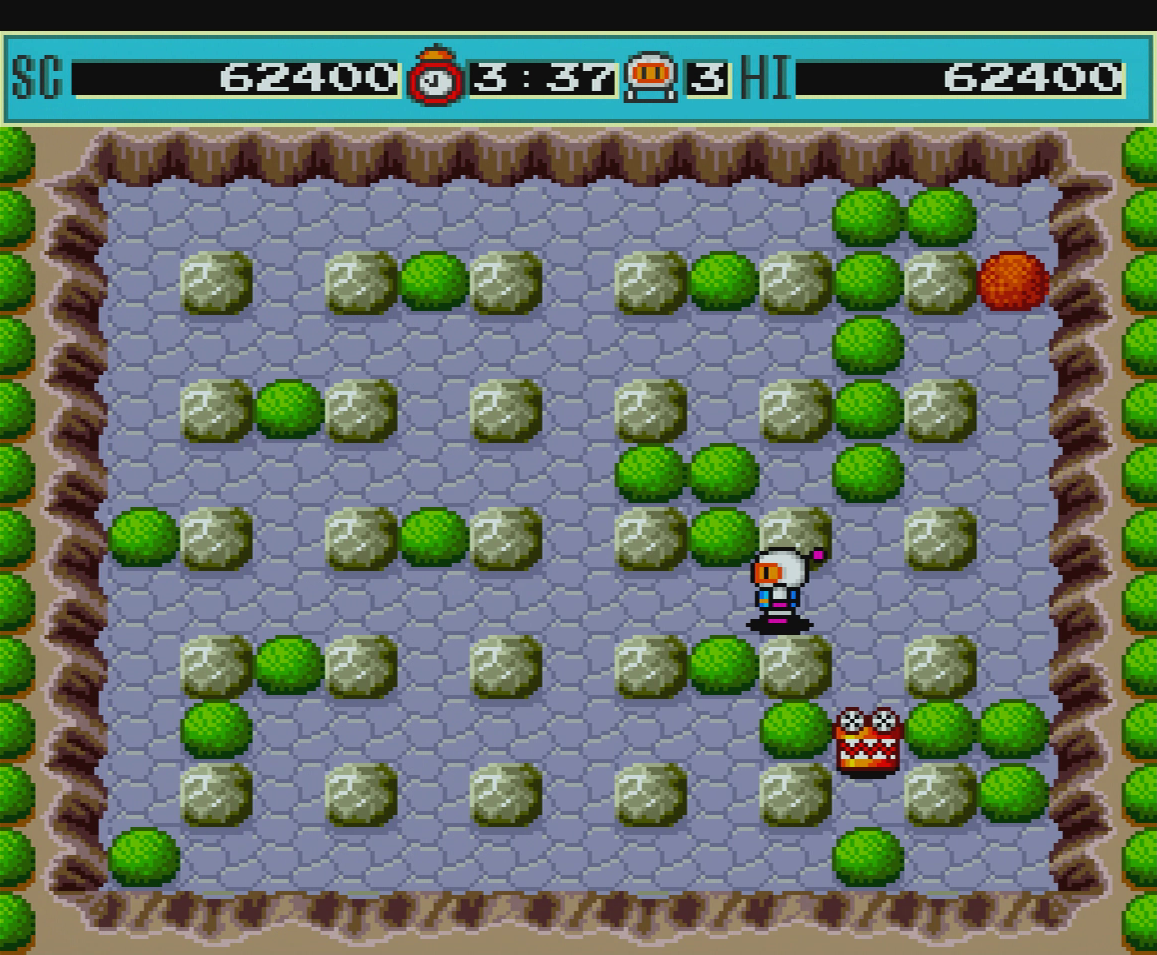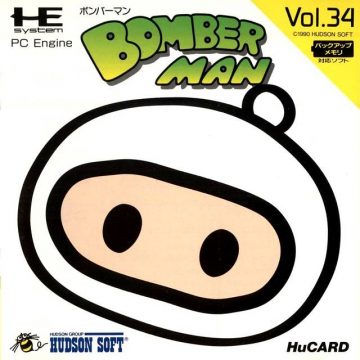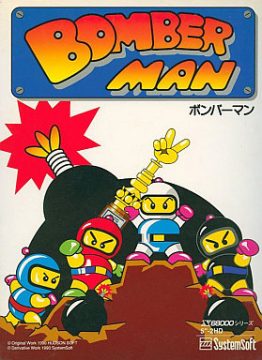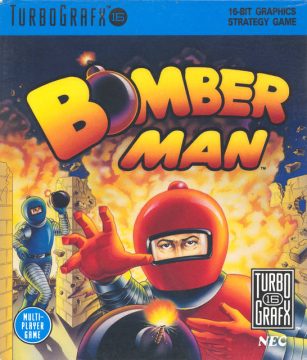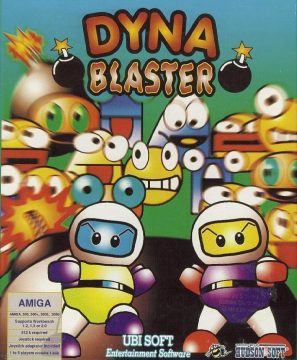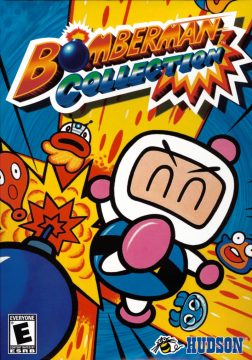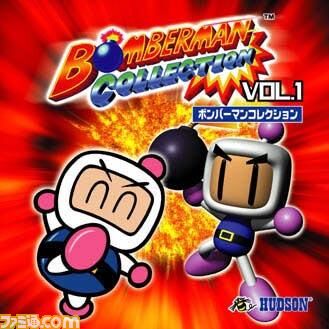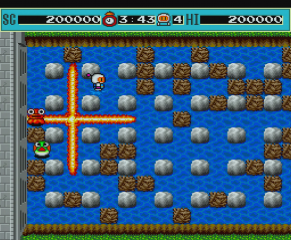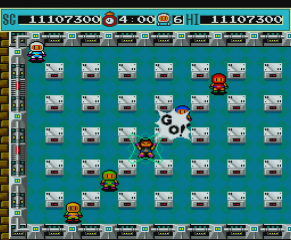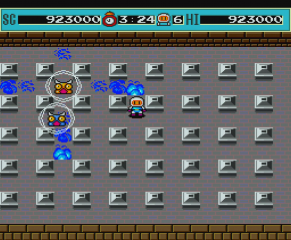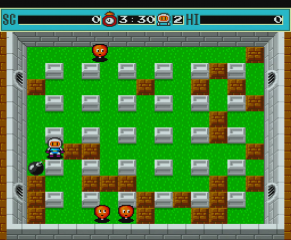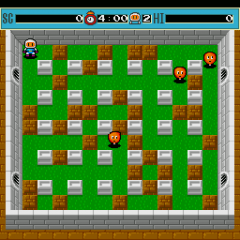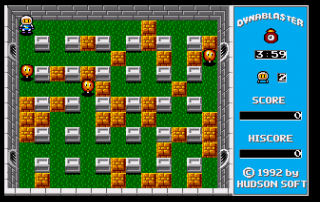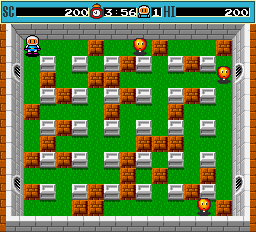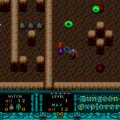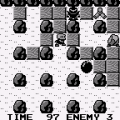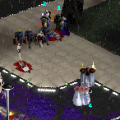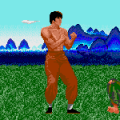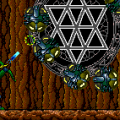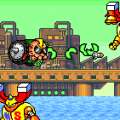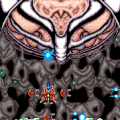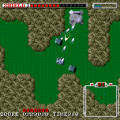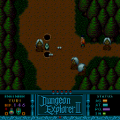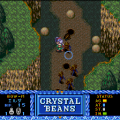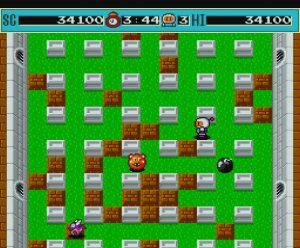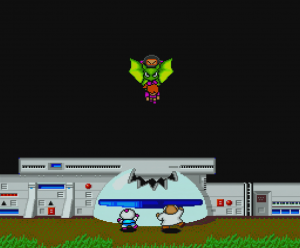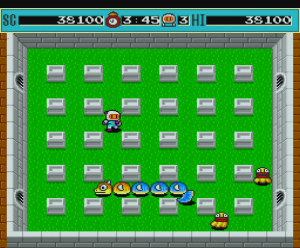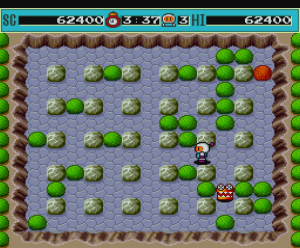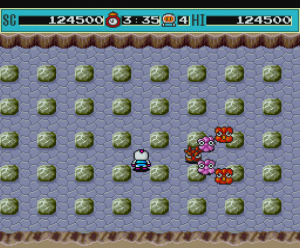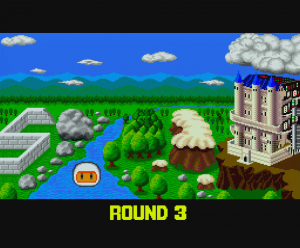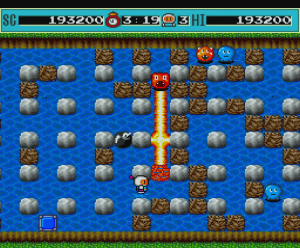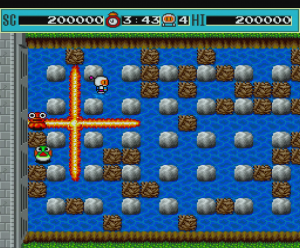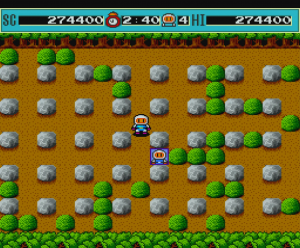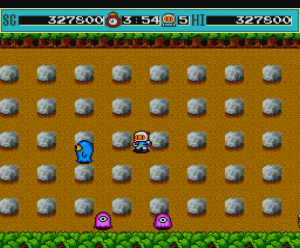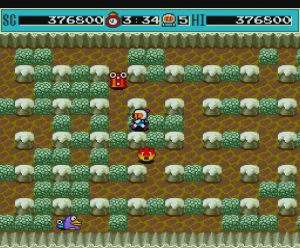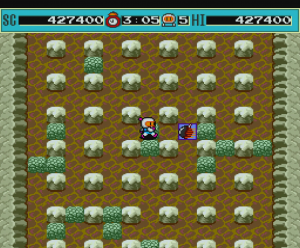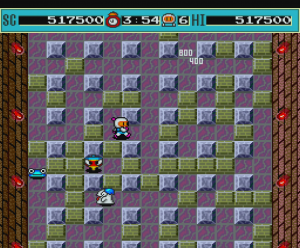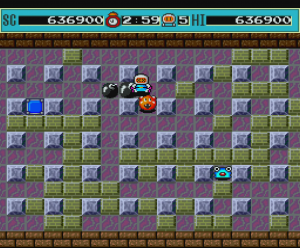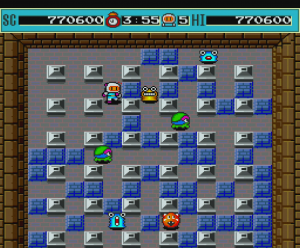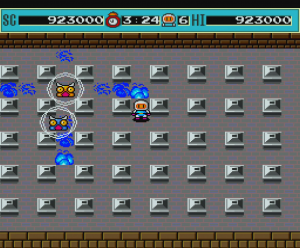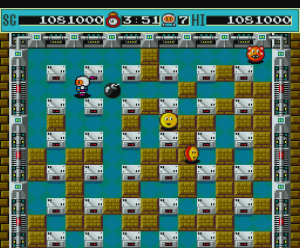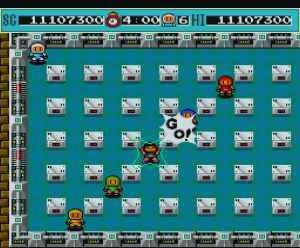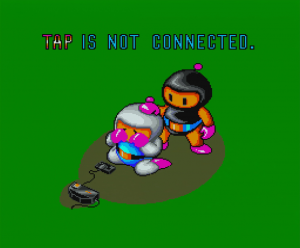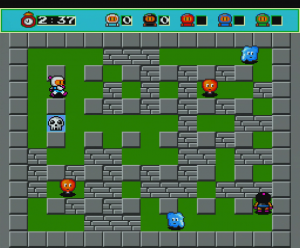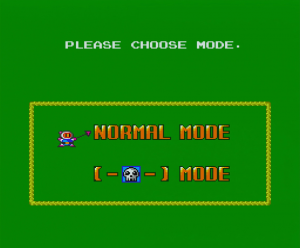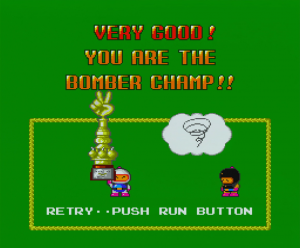- Bomberman Series Introduction / Bomberman (1983)
- 3-D Bomberman
- Bomberman (1985)
- RoboWarrior
- Atomic Punk
- Bomberman (1990)
- Atomic Punk (Arcade)
- Bomberman II
- New Atomic Punk: Global Quest
- Bomberman ’93
- Super Bomberman
- Hi-Ten Bomberman / Hi-Ten Chara Bomb
- Bomberman ’94 / Mega Bomberman
- Super Bomberman 2
- Super Bomberman 3
- Wario Blast: Featuring Bomberman
- Bomberman GB 2
- Bomberman: Panic Bomber
- Super Bomberman 4
- Saturn Bomberman
- Bomberman GB 3
- Bomberman B-Daman
Aside from being the year of the first portable entry in the series, 1990 would also be the first time the Bomberman franchise moves into the 16-bit generation with, well, Bomberman. Despite the identical title, this game isn’t a remake of its 1985 predecessor but rather feels like a true and proper continuation, eschewing the innovations and complexity of Robo Warrior and Atomic Punk in exchange for a return to the simple but engaging gameplay that gave the series its identity in the first place. It’s also worth noting that this is the first console entry to abandon Nintendo platforms, likely due to the fact Hudson Soft now had a partial stake in the “console wars” with the PC Engine. In terms of the single player experience, Bomberman can potentially be seen as a bit of a downgrade for those who grew attached to the economy and environmental challenges of Atomic Punk, but with the introduction of an expanded multiplayer mode, it’s undeniably a big turning point in the franchise’s history.
Like with Atomic Punk, a mostly different team at Hudson Soft developed Bomberman, though Jun Chikuma returned to compose the soundtrack. Designer Tsukasa Kuwahara went on to be a game designer on Bomberman ’93, a highly regarded entry in the franchise, and graphic designers Hideyuki Ogura and Mika Sasaki would go on to do map design for 1997’s Bomberman 64 and graphic design for Bomberman II respectively. This game is also the first in the series to have its sound design handled by Keita Hoshi, a prolific sound and music programmer for Hudson Soft who worked on games like Soldier Blade, Saturn Bomberman, and Bloody Roar 3.
Once again abandoning previously established lore, Bomberman is now the story of a justice-loving robot built by the famous Dr. Mitsumori in the pursuit of peace. However, things go wrong when Dr. Mitsumori attempts to build a second Bomberman in the image of the original, only to accidentally create Black Bomberman, who wants nothing more than to rule the world. Black Bomberman kidnaps the doctor’s daughter, Lisa, and flies off to his awfully convenient castle, forcing Bomberman to pursue him and save the day. The setup is somewhat similar to Mega Man (Black Bomberman even grovels at your feet à la Dr. Wily after you defeat him) and is charming enough, but Dr. Mitsumori and Lisa never return in future entries, which makes it all feel a bit moot. Black Bomberman’s introduction, however, is anything but. Not only does he serve as the quintessential “Player 2” character for much of the series, he ends up playing a consistent role in the story of several future entries, undergoing a character arc much like Dragon Ball Z’s Vegeta in which he goes from villain to rival to close friend, endearing himself to the audience with a more robust personality as time goes on.
Players of previous entries will immediately notice just how much Bomberman benefits from the power of a newer console. Everything is far more colorful and better animated, with the expressions of the Bombermen being a particular highlight. The intro and ending give each character enough personality to tell the story with minimal text, the river stages have an animated floor to simulate moving around in water, and when playing the multiplayer modes, each Bomberman will animate with visible pleasure or disappointment depending on the outcome of the session, encouraging you to do your best for Bomberman’s sake. Just make sure you don’t try to start multiplayer without a TurboTap plugged in – you’ll never live down how sad Bomberman looks if you do!
Jun Chikuma’s compositions here are also an improvement from her previous work, using music from the 1985 game as a basis for many of the tracks. That game’s stage theme does of course make a return, but now there are a handful of tracks used across the eight areas, along with boss battle themes to make those stages stand out more and mitigate any potential repetition. While it’s a shame not every area has a unique track like Atomic Punk, the quality of the music for this entry is no less impressive overall.
Bomberman is divided into eight rounds with eight parts each for a grand total of 64 levels, the highest amount in the series up to this point. The areas presented to the player are straightforward but varied enough in their appearance, taking them from a river to a forest, past some perilous mountains, and through a lava cave as well. Most of the game’s latter half takes place inside Black Bomberman’s castle, giving it an epic, climactic feeling much like Dracula’s castle in Castlevania. Your location is now depicted on a map that Bomberman travels across as he clears out each area, accentuating the adventure with a sense of momentum and palpable progress. However, the levels you’ll encounter aren’t anywhere near as complex as those in Atomic Punk – what you’ll see here is functionally the same as the Famicom game, since all of the backgrounds are just for flavor and there’s nothing the environments do to present any danger or new challenges. Many of the foes you’ll encounter are either from the Famicom game or are similar in nature to them, so you don’t need to apply any new strategies to survive. Once you get powered up, it’s easy enough to go through the entire game without dying much at all. In addition, saving is now supported alongside passwords should you run out of lives, making it easier than ever to jump back in.
Perhaps the biggest addition to the single player here is the introduction of bosses, though the idea doesn’t feel fully realized. Boss fights present a slightly larger than normal foe, such as the worm Arion or Bubbles, a boss capable of producing smaller versions of itself, and simply ask you to blow them up in a maze bereft of soft blocks. The problem here is that most of the bosses just end up playing out like a room full of standard enemies. Bosses don’t aggressively pursue you and it’s not until late in the game that they get actual attacks, so it’s not hard to take them out quickly. The final boss is at least a highlight of the game – Black Bomberman takes you on alongside four other Bombermen (Green, Yellow, Red, and Blue), resulting in a scrappy, thrilling battle not unlike a rigged multiplayer match, befitting of Black Bomberman’s villainous position.
The multiplayer is mostly similar in nature to that of the previous game, but with the option to include up to five people using a TurboTap. This alone vastly improves and changes the dynamic of the multiplayer, since adding more players into the mix is the easiest way to turn games into a proper riot. Form uneasy alliances, dogpile whoever’s stuck in the middle, play defensively and hoard power-ups, hide in the corner and let your opponents sort themselves out; anything goes when five people are crammed into the same arena! Should you decide to play with fewer than five people, the game will fill in some of the empty space with enemies from the single player – it’s an odd decision that doesn’t add a whole lot to matches and is ultimately done away with in later games. If you’re lucky enough to own a TurboExpress and know someone else with one, you can also link them together to play the “C-Link Battle” mode, though you’re limited to just two players by doing so.
Multiplayer is divided into two modes, “Normal Mode” and “Skull Mode”. The former is just the standard deathmatch option, but “Skull Mode” adds a very interesting ingredient to the proceedings – players have a chance of finding a Skull item, which grants a random effect to the recipient that they’ll likely regret having. The effects include things such as making you slow as molasses, preventing you from dropping bombs, forcing you to drop bombs automatically, or reducing your firepower to its lowest level. The introduction of the skull adds another layer to multiplayer gameplay, since players can either take the time to destroy them or leave them around and try to trick other players into grabbing them. If a player is feeling particularly cruel, they can intentionally grab a skull and spread its effect to other players by making contact with them, adding yet another layer of chaos. The skull remains a mainstay of multiplayer from this point onward, serving as the first of many clever iterations upon the winning formula.
The box art for the North American version depicts Bomberman as a human in a ridiculous looking costume in the vein of the infamous “Bad Box Art Mega Man”. This depiction of the character thankfully isn’t reflected in the game itself, but the 2014 Japan-exclusive Bomberman mobile game paid its respects to this lovely box art by allowing “Cyborg #0898” to join the fray alongside a bunch of the wackiest Bombermen around.
Bomberman was included as a pack-in title for the TurboDuo via the4 in 1 Super CD. For whatever reason, the game has to be accessed by entering a code on the game selection menu (Up, Right, Down, Left, II). Once you’re in, it’s otherwise the same game sans the TurboExpress connectivity, but you’ll have to re-enter the code every time you turn off the console, so it’s a bit inconvenient if you’re playing multiplayer and want to switch modes.
Over the course of two years, Bomberman ended up on several contemporary computers, most of which were exclusive to Europe and were all renamed Dyna Blaster accordingly, but the Sharp X68000 version was exclusive to Japan and retains the Bomberman name. Some versions, such as the X68000, reduce the maximum player count to four, whereas the Atari ST and MS-DOS versions still allow for five players. A Commodore 64 version was planned but ultimately cancelled due to the shrinking market share of the platform at the time.
On the Atari ST, the music is completely different, using chirpy chiptune beats that don’t really suit the game but are extremely upbeat and rather catchy in their own right. This version also has a completely different HUD compared to the other versions, opting for a slightly more intrusive status bar on the right side of the screen instead of the top. The Amiga version has higher quality instrumentation, but sounds somewhat harsh and tinny at the same time. Most notable about the Amiga version is the new track used for the credits, the “Actionamics Anthem” (Actionamics being the team responsible for the Amiga port), composed by Eike Steffen – it’s an absolute flex of a track that shows off the Amiga’s sound capabilities with style. The MS-DOS version fares the poorest, with drastically slowed down music and an extra harsh, somewhat unpleasant sound to it all. There aren’t many buttons to begin with, but the MS-DOS version does allow you to remap them, which is a nice gesture. SystemSoft was responsible for the X68000 and while the music is the same as the original version, it benefits from the hardware’s excellent sound capabilities with crisper sound and improved instrumentation.
Several years later in 2002 and 2003, a port of Bomberman was made available via Bomberman Collection, a compilation for PC that also contains Bomberman ’93 and Bomberman World. It’s an emulation of the original game (it even has the “C-Link Battle” mode despite it being impossible to use!), but it does let you bind controls like the MS-DOS version did.
Bomberman Users Battle
Bomberman was big enough as a multiplayer phenomenon by now and Hudson Soft saw fit to bring the game around to places like demo kiosks, tournaments, and their yearly Caravan competitions. To commemorate these events, a special HuCard by the name of Bomberman Users Battle was given out to participants in exceptionally small numbers, estimated to be around 1,000 units. There’s no concrete evidence of this game being played or distributed in its intended environment anywhere on the internet, but considering Hudson Soft would go on to do something similar yet exponentially more elaborate with Hi-Ten Bomberman and Hi-Ten Chara Bomb in 1993 and 1994, testing the waters with a simpler version like this back in 1990 makes enough sense. Naturally, this game is an excessively valuable trophy of sorts nowadays, but don’t worry about missing out because it’s just the multiplayer of the original game on a different HuCard. The only differences here are a new title screen and the modes being renamed to “Users Battle 1” and “Users Battle 2,” respectively.
Screenshot Comparisons
Links
https://game.watch.impress.co.jp/docs/newsclip/674626.html – Article about the 2014 mobile game with an image of Cyborg #0898
http://randomhoohaas.flyingomelette.com/bomb/mob/2014/game.html#char – Website with images of every playable character in the 2014 mobile game
https://www.gamesthatwerent.com/gtw64/dynablaster/ – Information on the cancelled C64 version
http://www.retroisle.com/gamedetails.php?n=Dyna%20Blaster&id=27357 – Website containing a screenshot for a supposedly cancelled Atari Lynx version
